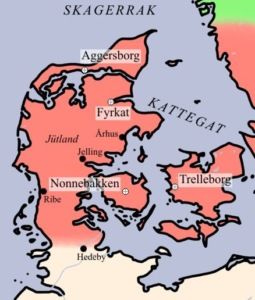Archaeologists can finally confirm that the remains of a Viking Age circular fortress found in the Vallo Diocese estate near Køge south of Copenhagen is indeed the fifth of its kind – a castle and settlement dating back to the reign of Harald Bluetooth in the late 900s.
Using dendrochronology – the study of tree rings, which is significantly more accurate than carbon-dating – the archaeologists can confirm that a one-metre piece of treated oak found at the site, which was probably part of a door or bridge, dates back to around 966.
READ MORE: New Viking fortress found near Køge
Initial doubts
When ‘Borgring’ was found in 2014, it was heralded as the first such discovery for 60 years and the third largest of the five circular fortresses in Denmark, but since then several archaeologists have sown doubt on its origins – particularly as excavation work has yielded little evidence the castle was lived in.
The discovery of glass beads, a toolbox and English ceramics weren’t exactly conclusive, but in recent months onsite archaeologists have found traces of Viking roads leading to the settlement, along with evidence they were in regular use.
Proudly a member now
The dating of the oak appears pretty conclusive. In fact, Borgring could be the oldest of the fortresses, as three – Nonnebakken (after 967), Fyrkat (974-75) and Trelleborg (980-81) – have been dated, leaving Aggersborg as the only castle archaeologists are unsure about.

Since June 2016 thousands have visited the Borgring site to watch the archaeologists at work, and now finally everyone can rest assured that the settlement is exactly what it was claimed to be: one of Harald Bluetooth circular fortresses.















